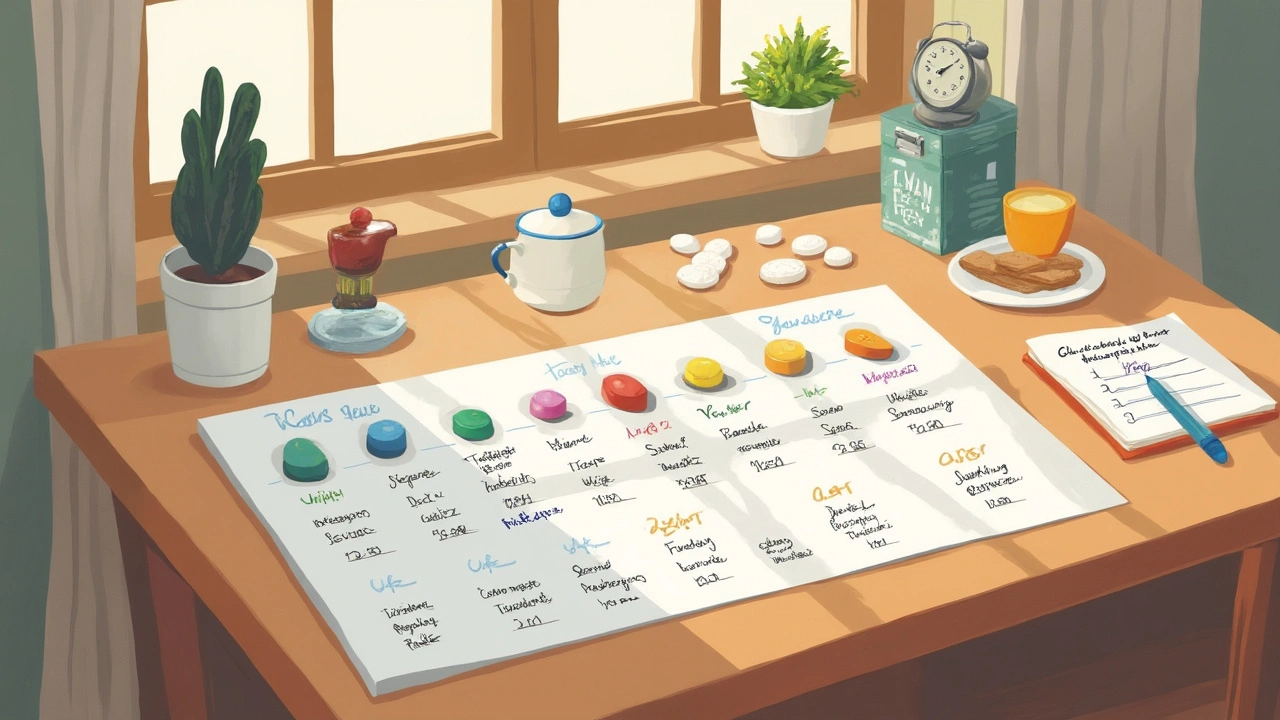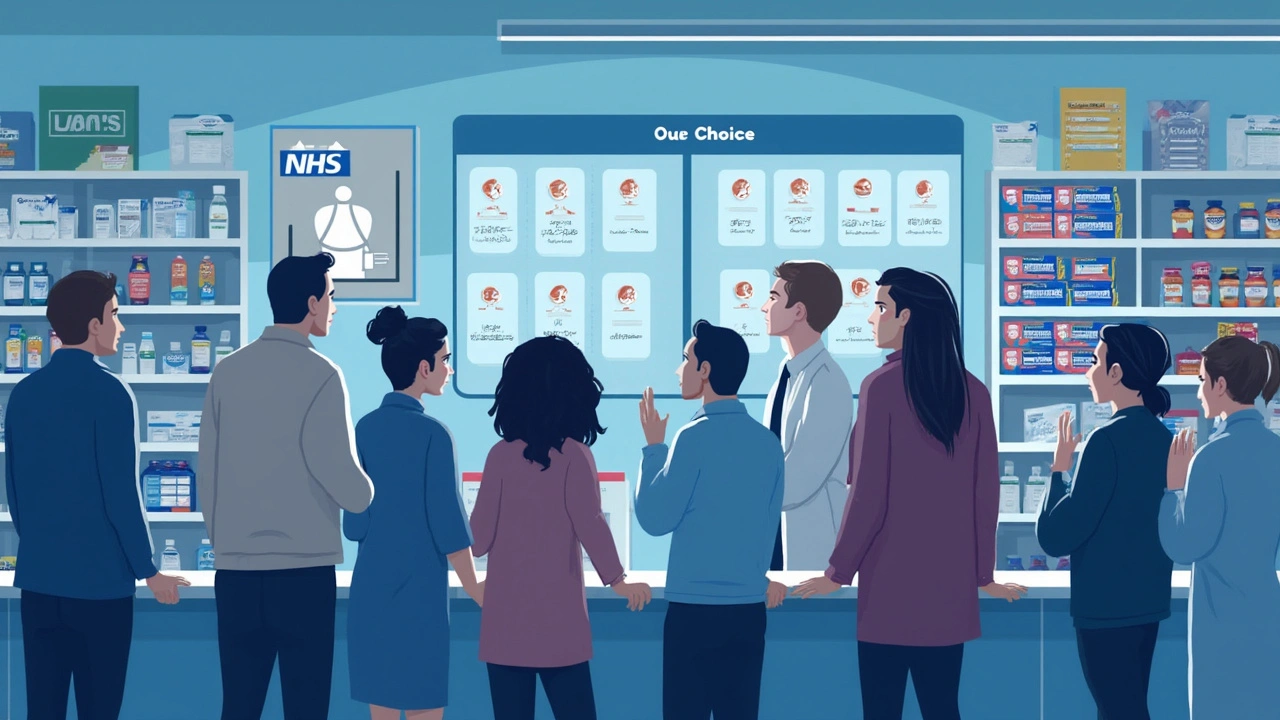If your doctor ever suggests switching off Losartan, it’s easy to feel lost in a sea of strange medication names and what-ifs. But guess what? You’ve actually got plenty of legit alternatives—and each one brings its own set of perks (along with a couple of quirks).
Blood pressure control isn’t a one-size-fits-all thing. Maybe Losartan isn’t lowering your numbers enough or causes side effects, or maybe your insurance suddenly stopped covering it. Regardless, you’re not stuck—you’ve got a whole lineup of meds that do a similar job but in slightly different ways. Think ACE inhibitors, ARBs, calcium channel blockers, and more. Each one tackles high blood pressure from a different angle, which means you can find the right fit for your own situation, health conditions, and even lifestyle.
What matters most? Knowing the differences. If you get the basics down (like who should watch out for a dry cough, or which drug might be better for your kidneys), your next chat with your healthcare provider will be a whole lot less intimidating. The idea here is simple: lay out the main alternatives to Losartan, sort out the pros and cons, and give you tips that actually matter in real life.
- Quinapril
- Valsartan
- Telmisartan
- Enalapril
- Olmesartan
- Irbesartan
- Candesartan
- Lisinopril
- Amlodipine
- Hydrochlorothiazide
- Summary Table and Comparison
Quinapril
First up, Quinapril is an ACE inhibitor, which basically means it helps your blood vessels relax (so your heart doesn’t have to work as hard) and keeps your blood pressure in check. It’s often used for high blood pressure and can even help if you’ve got congestive heart failure. One thing that makes Quinapril a bit unique: it binds to tissue in your body, which can help it stick around longer and act more steadily. That’s a small but useful difference compared to some other ACE inhibitors.
Doctors like Quinapril especially for people with hypertension who also have kidney problems or diabetes. That’s because it can help protect the kidneys while treating high blood pressure, which is a big deal for folks at risk of kidney damage. There are combo pills available that pair Quinapril with a water pill (hydrochlorothiazide), which can make things a little simpler if you need both types of meds.
Pros
- Protects the kidneys—especially good for people with diabetes and at risk of kidney disease.
- Can often be taken just once a day, so it fits into daily routines more easily.
- Available as a combo pill with hydrochlorothiazide (a diuretic) so you might take fewer pills overall.
Cons
- One major side effect: dry, hacking cough that doesn’t go away (known as the "ACE cough"). If you get this, you probably have to switch meds.
- There’s a rare but serious risk of angioedema, which means swelling of the face, lips, or throat—don’t shrug this off, it’s a medical emergency.
- You need regular blood tests to keep an eye on kidney function and potassium levels—especially if you have other health issues.
- Don’t use Quinapril if you’re pregnant or even thinking about it; ACE inhibitors aren’t safe here.
Here’s a quick look at some numbers:
| Side Effect | Chance (approximate) |
|---|---|
| ACE-related cough | 5-20% |
| Angioedema | <1% |
| Electrolyte imbalance | 1-5% |
If you and your doctor are chasing better blood pressure results and kidney protection, Quinapril can be a solid pick. But the pesky cough is a deal-breaker for a lot of people—watch for it in the first month or two.
Valsartan
Valsartan is another common choice when it comes to losartan alternatives. It’s an ARB—short for angiotensin receptor blocker—so it works pretty much like losartan does: it helps relax your blood vessels, making it easier for your heart to pump and, in turn, lowers your blood pressure. Fun fact: Valsartan was one of the most prescribed ARBs in the world before 2018, when a few production issues made some news (mainly about contamination, which has long been fixed).
If your doctor switches you from losartan to valsartan, you’ll probably notice your pill looks different, but the two drugs tackle hypertension almost the same way. The main differences? Valsartan may be a bit longer acting, so you might only need it once daily. It’s also often used for treating heart failure or for patients who’ve recently had a heart attack.
Pros
- Works nearly identically to losartan, so adjusting your dosage feels familiar.
- Shown to lower blood pressure effectively, with lots of real-world data to back it up.
- Helpful for people with heart failure or recent heart attack—valsartan got FDA approval for these cases.
- Less likely than ACE inhibitors to give you that nagging cough.
Cons
- Some people still get dizziness or a mild headache, especially when starting out.
- Blood testing needed at times (it can affect potassium and kidney function, like all ARBs).
- Folks with certain kidney issues or who are pregnant should usually avoid this drug.
Here's a useful fact: In a study with more than 10,000 patients (the VALUE trial), valsartan did just as well as its main competitor in preventing strokes and heart problems. So if you’re anxious about switching, you can at least know it’s a tried-and-true option for most folks dealing with hypertension.
| Average Dose (mg/day) | Typical Use | Common Side Effects |
|---|---|---|
| 80-320 | Hypertension, Heart Failure | Dizziness, Fatigue, Back Pain |
Telmisartan
Telmisartan is another popular player in the losartan alternatives club. Just like Losartan, it’s an ARB (angiotensin receptor blocker), but it’s got a few tricks up its sleeve that make it stand out when you’re talking about blood pressure medication.
One thing that makes Telmisartan unique: it sticks around in your body longer than most other ARBs. That means once-a-day dosing is really enough—no need to set alarms for a second pill. Handy, right?
A lot of doctors look at Telmisartan when someone needs help with both hypertension and metabolic issues like prediabetes or high cholesterol. There’s research showing Telmisartan can actually make your body more sensitive to insulin and might help manage blood sugar a bit. It also does a solid job protecting kidneys, especially in people with diabetes—a point many experts like to see in a losartan alternative.
Pros
- Longer-acting than most ARBs; true once-daily dosing
- Good for kidney protection, especially in diabetic patients
- May improve insulin sensitivity (unusual among ARBs)
- Usually well tolerated, with a low risk of dry cough
- Available in combo pills with other blood pressure meds
Cons
- Can cause dizziness or lightheadedness, especially at the start
- Like other ARBs, not considered safe in pregnancy
- Can raise potassium levels—requires lab monitoring
- Often pricier than Losartan or older ARBs
Some numbers? In a comparison study, Telmisartan kept blood pressure in check for a full 24 hours in over 80% of participants, while shorter-acting options faded sooner. So if you’ve had trouble with BP spikes at night or early morning, this could actually make a real difference.
When talking choices with your provider, remember to discuss things like cost and insurance, because Telmisartan isn’t always on all formularies. But if you want simple dosing and a little extra protection for your kidneys or blood sugar, it’s a front-runner among losartan alternatives.
Enalapril
If you’ve ever heard of ACE inhibitors, Enalapril always pops up near the top of the list. It’s been around for a long time and is especially popular with doctors for treating high blood pressure and heart failure. What makes Enalapril different from Losartan and other ARBs? For one, it works by blocking an enzyme called ACE, which your body uses to make a hormone that tightens blood vessels. When that enzyme gets blocked, your blood vessels relax and pressure drops.
Enalapril doesn’t just drop your numbers; it’s well-known for protecting your heart in the long run. That’s especially helpful for people who have heart problems, kidney disease, or diabetes. There’s a solid track record here—this stuff has been studied for decades. In fact, some research shows that using Enalapril can help prevent hospitalizations if you already have heart failure, and it's even recommended by the American Heart Association in certain cases.
Pros
- Long history of safe use for high blood pressure and heart failure
- Can reduce hospitalizations in people with heart issues
- Protects kidney function, especially helpful for diabetic patients
- Usually available as a cheap generic, so your wallet doesn’t take a hit
Cons
- Common side effect: dry, persistent cough (that doesn’t go away until you stop the drug)
- Can rarely cause angioedema, a swelling reaction—if your lips or face swell, you need help, fast
- Needs close lab monitoring, especially for kidney function and potassium levels
- Not recommended during pregnancy due to risk of birth defects
Here’s a simple comparison table showing some quick facts about Enalapril versus Losartan:
| Feature | Enalapril | Losartan |
|---|---|---|
| Drug Class | ACE Inhibitor | ARB |
| Typical Side Effect | Cough, angioedema | Dizziness, occasional kidney issues |
| Pregnancy Safe? | No | No |
| Kidney Protective? | Yes | Yes |
| Generic Available? | Yes | Yes |
If your insurance doesn’t cover Losartan or you’re looking for a backup that’s just as respected but costs less, Enalapril is honestly worth asking your doctor about—just make sure you’re cool with having your labs checked and watching out for that annoying cough.
Olmesartan
Let’s talk about Olmesartan, another prescription in the ARB family. If Losartan wasn’t cutting it or brought on side effects, Olmesartan might be suggested instead. It goes by brands like Benicar, and it’s all about lowering blood pressure and protecting your heart and kidneys. Unlike ACE inhibitors, Olmesartan usually skips the cough issue—which is a big relief for a lot of people.
One cool thing? Olmesartan generally works well for most age groups and is especially useful in people who have both high blood pressure and Type 2 diabetes. It’s once-daily, so you don’t have to deal with remembering multiple doses. Plus, research shows Olmesartan can get blood pressure averages even lower than other ARBs in some patients:
| Drug | Systolic BP Drop (mmHg) | Diastolic BP Drop (mmHg) |
|---|---|---|
| Losartan | -12 | -8 |
| Olmesartan | -15 | -10 |
That’s a small but meaningful difference for some people trying to hit their target numbers. Just remember—these effects vary person to person, and your results could be different based on your own health picture.
"Olmesartan is an effective antihypertensive agent and is generally well tolerated, with an adverse event profile similar to placebo." – American Journal of Cardiovascular Drugs
Pros
- No persistent cough (unlike ACE inhibitors like Lisinopril)
- Often stronger at lowering blood pressure than some other ARBs
- Works well for people with diabetes or kidney issues
- Usually just one dose a day
Cons
- In rare cases, can cause severe diarrhea and weight loss (called "sprue-like enteropathy")
- Not recommended in pregnancy
- Can bump up potassium levels, so blood tests are needed
- May cost more and isn’t always on every insurance plan
Bottom line, Olmesartan is a solid choice if you’re looking for a no-cough alternative and want something powerful and easy to use for hypertension. Just be sure your doc checks your blood work now and then, especially if you’ve got kidney problems.

Irbesartan
If you’ve looked into losartan alternatives, Irbesartan is probably on your radar. It’s another ARB (angiotensin receptor blocker), and people use it for high blood pressure and to protect kidneys, especially in those with type 2 diabetes. Irbesartan blocks the same signals as Losartan, so in practice, the benefits line up pretty closely.
Doctors like the fact that Irbesartan is usually taken once daily, and the starting dose is easy to remember—most people begin at 150 mg each day. If your blood pressure is stubborn, the dose can go up to 300 mg. What really gives it an extra point is its kidney-protective effect. Recent data shows Irbesartan can slow down kidney damage, which is why it's a favorite for people with diabetes and high blood pressure. There’s even a brand called Avapro, but plenty of cheaper generic options exist if you want to save money at the pharmacy.
Let’s break down the practical side.
Pros
- Usually well tolerated—less risk of cough compared to ACE inhibitors
- Once-daily dosing keeps things simple
- Clinically proven to protect kidneys, especially for diabetics
- Lower risk of angioedema (the scary swelling some people get from ACE inhibitors)
- Available as a generic, so it’s more affordable in most pharmacies
Cons
- Not much use if you have severe kidney issues already—needs regular kidney tests
- Doesn’t mix well with potassium supplements or salt substitutes (risk of high potassium)
- Sometimes causes dizziness, especially at first
- Not usually safe in pregnancy
- May not be as widely available in combination pills as other drugs
Check out how Irbesartan stacks up against Losartan on the kidney side, based on some study data:
| Irbesartan | Losartan | |
|---|---|---|
| Kidney protection in diabetics | Well-studied, strong benefit | Good benefit, less studied in type 2 diabetes |
| Dose range (mg) | 150–300 mg once daily | 25–100 mg once or twice daily |
| Main side effect worry | Dizziness/hyperkalemia | Dizziness/cough (rare) |
If Losartan never quite fit for you, especially if you’re diabetic and worried about your kidneys, Irbesartan could actually check all the boxes. Just make sure your doctor keeps tabs on your kidney function and potassium level after you switch.
Candesartan
Candesartan is another solid choice if you’re looking for losartan alternatives. Like Losartan, it’s an angiotensin II receptor blocker (ARB), meaning it lowers blood pressure by helping blood vessels relax. Doctors often reach for Candesartan for folks who have high blood pressure that’s a bit more stubborn or for people dealing with heart failure. It’s also handy for people who didn’t get good results, or had side effects, from other ARBs.
Here’s a cool thing: compared to some other ARBs, Candesartan works a little longer in your system—taking it once a day usually does the trick. Studies show it doesn’t just lower blood pressure, but can protect your heart over the long haul. Some researchers even say it’s among the strongest ARBs in terms of bringing those numbers down.
Got kidney issues? Candesartan is often better tolerated and less likely to mess up kidney function compared to options like ACE inhibitors. Plus, it doesn’t commonly cause a cough, which is a win if you can’t stand that annoying ACE-inhibitor tickle.
Pros
- Works all day with just one dose
- Rarely causes cough or angioedema (face or throat swelling)
- Can help protect heart and kidneys
- Generally few drug interactions
- Often preferred for patients with diabetes or mild kidney disease
Cons
- Can cause dizziness—especially when you first start
- Not recommended in pregnancy
- Doesn’t play well with high doses of potassium (risk of high potassium levels)
- Might need kidney function and potassium checked now and then
- Brand name can be pricey if your insurance doesn’t cover the generic
If you’re curious about how Candesartan performs compared to Losartan, one review from 2022 showed Candesartan often led to a bigger drop in blood pressure over 24 hours—especially for folks with tough-to-treat hypertension.
| Feature | Candesartan | Losartan |
|---|---|---|
| Typical Dose | 8-32 mg daily | 25-100 mg daily |
| Time to Peak Effect | 6-8 hours | 1-3 hours |
| Bradykinin Cough Risk | Very low | Very low |
| Renal Protection | Yes | Yes |
Bottom line? Candesartan checks a lot of boxes for people looking for a long-lasting ARB to handle stubborn blood pressure, especially if they need something easy on the kidneys.
Lisinopril
Lisinopril is a popular ACE inhibitor often used when people need an alternative to losartan. Docs hand it out for both high blood pressure and heart failure. While it helps keep your blood vessels relaxed (pretty much like losartan), it comes from a different drug family—meaning the side effects and benefits can shift.
What makes lisinopril stand out? It’s inexpensive and it works for a lot of people, especially those with other conditions like diabetes or kidney disease. It’s taken once a day and doesn’t need a complicated routine. Lisinopril can also be used in combo pills with diuretics, making treatment simple for folks juggling multiple meds.
Pros
- Cuts down risk of heart attack and stroke like most blood pressure meds
- Often protects kidney function, especially in diabetes or kidney issues
- Usually taken just once daily
- Affordable and widely available
- Available as a combo with hydrochlorothiazide to further lower blood pressure
Cons
- Dry cough is pretty common—about 10% of users get it and some have to switch meds
- Rare but serious side effect: angioedema (sudden swelling; needs urgent care if it happens)
- Needs kidney function and potassium checked, especially when starting out
- Not recommended in pregnancy—could be dangerous to the baby
Here’s a handy snapshot from recent research on how ACE inhibitors like lisinopril stack up for preventing serious events in patients with high blood pressure:
| Outcome | Relative Risk Reduction |
|---|---|
| Stroke | ~28% |
| Heart Attack | ~20% |
| Heart Failure | ~25% |
Lisinopril is honestly a workhorse in the blood pressure medication world. But talk to your provider if you notice a nagging cough, swelling, or anything that feels off. It’s effective, but, like all meds, it’s not a perfect fit for everyone.
Amlodipine
Amlodipine is a super popular option for treating high blood pressure and chest pain (angina). It falls under the group called calcium channel blockers. While Losartan is all about blocking angiotensin receptors, amlodipine relaxes your blood vessels by stopping calcium from getting into the muscle cells of your heart and arteries. This helps blood flow easier and takes some of the stress off the heart.
Want a medication that's pretty gentle on the kidneys and rarely causes coughing? Amlodipine checks those boxes. It's often used alongside other blood pressure meds and is famous for its long-lasting effect. Most people only need to take it once a day.
"Amlodipine remains a reliable first-line agent for hypertension, especially in patients who can’t tolerate ACE inhibitors or ARBs." — Mayo Clinic Proceedings, March 2023
One thing to know: amlodipine is a favorite in the over-65 crowd because it doesn't mess with potassium like some other blood pressure pills. It's also a go-to for folks with African ancestry, where it's been shown to lower blood pressure effectively.
Pros
- Long-acting, just one pill a day covers you for 24 hours
- Low risk of cough or kidney problems
- Works great in combo with other blood pressure drugs
- Good choice for African American patients based on clinical studies
- Can help with chest pain (angina) at the same time
Cons
- Can cause ankle swelling (edema) in some people
- Headache and flushing are pretty common at first
- Doesn’t protect the kidneys as directly as some ACE inhibitors or ARBs
- May not be the top choice if you have severe heart failure
Doctors will usually start you at a low dose and bump it up if your blood pressure isn’t where it should be after a few weeks. According to CDC data, about 14% of blood pressure prescriptions in the US include amlodipine or a related drug—so you won’t be the odd one out.
| Typical Dose | How Fast It Works | Key Side Effect |
|---|---|---|
| 5–10 mg once daily | 4–8 hours to kick in | Ankle swelling |
If you’ve tried Losartan and it isn’t doing the trick, or side effects are bugging you, amlodipine is worth talking about with your doctor. Bring up any swelling or dizziness—those are common but can usually be managed if you catch them early.
Hydrochlorothiazide
This one's an old-school favorite in the world of blood pressure medication. Hydrochlorothiazide, usually just called HCTZ, belongs to the thiazide diuretic group—yeah, that's a fancy way to say it makes you pee more. That’s the main trick: it helps your body flush out extra salt and water, which can lower your blood pressure and reduce swelling.
Doctors have been reaching for HCTZ for decades to help manage hypertension. It’s often prescribed alone, but you'll also see it mixed with meds like losartan or lisinopril in combo pills, since it teams up well with ACE inhibitors and ARBs.
Pros
- Affordable and generic—most insurance plans cover it.
- Usually well-tolerated at standard doses.
- Reduces risk of stroke and heart attack when used long term.
- Pairs well with other hypertension drugs for extra effect.
- Works fast—you’ll see your blood pressure change within about one to two weeks.
Cons
- Can cause more frequent urination, especially in the first few weeks.
- May lower potassium too much, which could lead to muscle cramps or irregular heartbeat.
- In higher doses, sometimes raises blood sugar or cholesterol.
- Not the hottest choice for folks with poorly controlled gout, since it can raise uric acid.
- May make you more sensitive to sunlight.
Here’s a quick look at how Hydrochlorothiazide stacks up in the real world (just to give some numbers):
| Effect | Hydrochlorothiazide (HCTZ) | Losartan |
|---|---|---|
| Average BP drop (mmHg systolic) | 10-15 | 10-15 |
| Onset of action | 2 weeks | 3-6 weeks |
| Common combo options | + Losartan, + Lisinopril | + HCTZ |
If you're thinking about switching to or adding HCTZ, have a chat about potassium and kidney checks every few months—just to be safe. And a heads-up: don't get thrown off if you see the name in a combo pill. Seeing "HCTZ" tacked onto another med is common and, for a lot of people, works better than taking either drug alone.

Summary Table and Comparison
Sorting through losartan alternatives isn’t just about memorizing drug names. You want to spot what actually makes them different—like which ones cause cough, which save your kidneys, and which will show your wallet some mercy at the pharmacy. Here’s a side-by-side look that makes these blood pressure meds less confusing.
| Medication | Type | Kidney Friendly? | Main Side Effects | Special Tips |
|---|---|---|---|---|
| Quinapril | ACE Inhibitor | Yes | Cough, angioedema | Good for diabetics, needs kidney monitoring |
| Valsartan | ARB | Yes | Rare: dizziness | Less likely to cause cough |
| Telmisartan | ARB | Yes | Back pain, sinus issues | Long-acting, supports heart health |
| Enalapril | ACE Inhibitor | Yes | Cough, high potassium | Available as injection (for emergencies) |
| Olmesartan | ARB | Yes | Diarrhea (rarely sprue-like) | Very long-lasting |
| Irbesartan | ARB | Yes | Dizziness, rare fatigue | Helpful for diabetics with kidney disease |
| Candesartan | ARB | Yes | Headache | Backed by strong heart failure data |
| Lisinopril | ACE Inhibitor | Yes | Cough, high potassium | One of the most prescribed in the U.S. |
| Amlodipine | Calcium Channel Blocker | No effect | Swelling in ankles | Won’t protect kidneys like ARBs/ACE-I |
| Hydrochlorothiazide | Thiazide Diuretic | No, can stress kidneys | Low potassium, urination | Cheap, widely used |
The gist? If you’re dealing with diabetes or kidney problems, those ACE inhibitors and ARBs (like lisinopril or valsartan) tend to be favorites, mainly because they’ve actually been shown to protect your kidneys as you age. But if you can’t handle the dry cough ACE inhibitors sometimes cause, the ARBs are your next go-to.
If swelling drives you nuts, steer clear of amlodipine. If cost is your top concern, hydrochlorothiazide and lisinopril are usually the cheapest options at the pharmacy (sometimes free). No option is perfect, so your doctor will match the best fit based on any chronic health stuff you’ve got, your side effect tolerance, and other meds you’re on. This table can help you steer the conversation and ask better questions: that’s real power when it comes to your blood pressure medication choices.






Ellie Haynal
July 18, 2025 at 11:32
Wow, this post is honestly a breath of fresh air! Dealing with hypertension meds is such a rollercoaster, and it’s so easy to feel overwhelmed when your doctor throws a bunch of big drug names at you. Having a clear guide like this just screams relief to me. I’ve been on Losartan before, and while it worked for a bit, the side effects were brutal for my anxiety issues.
The breakdown between ACE inhibitors and beta blockers was especially useful. It’s not just about controlling blood pressure but also considering how these meds affect your mental health and emotional state. It would be fantastic if the post dug a little deeper into lifestyle tweaks that can complement these medications. I mean, come on, meds plus healthier habits could be the real game changer!
Anyway, for anyone out there struggling with their current meds, this guide could be the perfect stepping stone to a more informed conversation with their doctor. I’m bookmarking this one for sure!